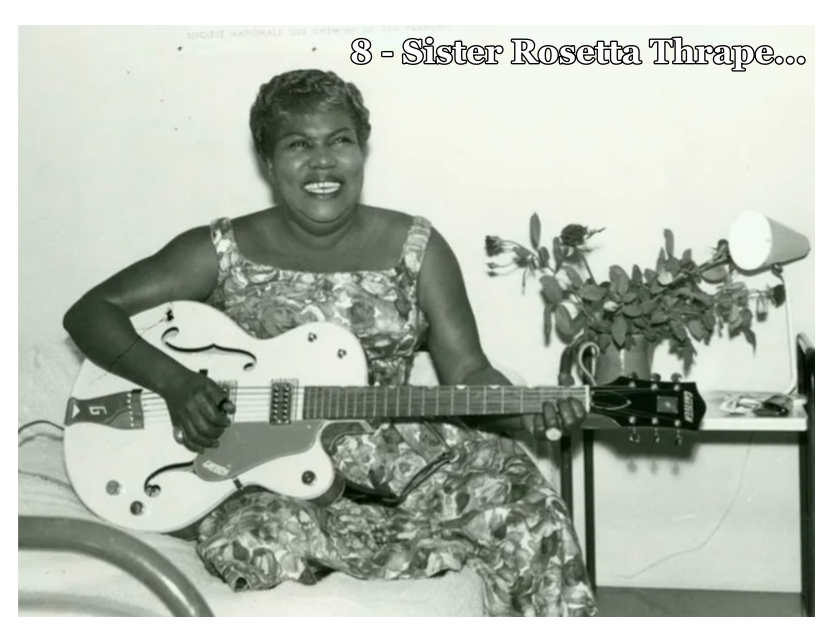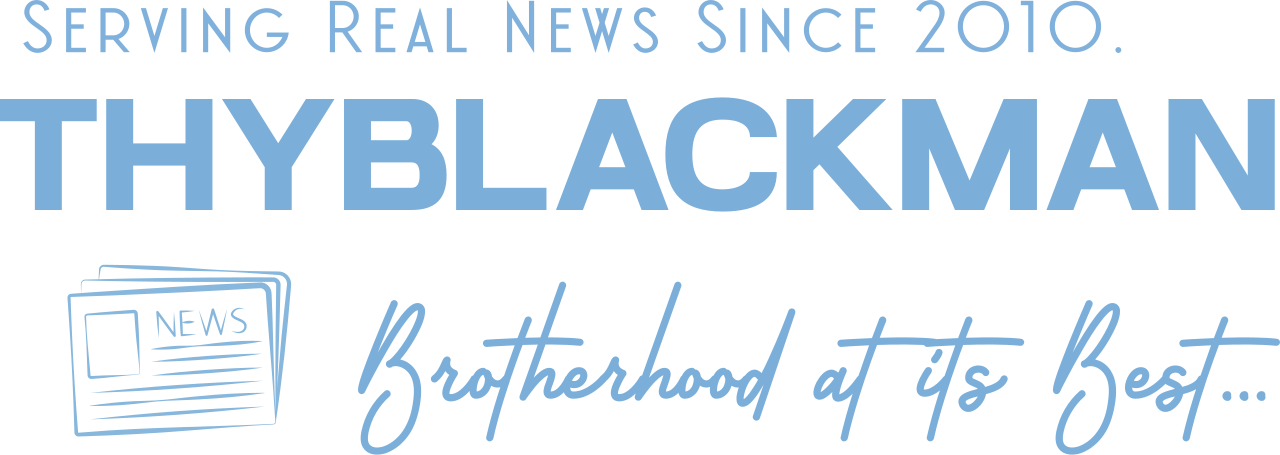(ThyBlackMan.com) If you’ve ever found yourself swaying to a gospel melody or air-guitaring to a gritty rock riff, you might owe a quiet nod of thanks to Sister Rosetta Tharpe. She’s not just a name buried in music history — she’s the unsung architect of it all. Long before guitar gods lit up arenas, Rosetta was tearing through electric solos in church halls and concert stages alike, blending the sacred with the soulful in ways that still feel daring today.
Discovering her music is like opening a time capsule that somehow sounds fresher than half the songs on today’s charts. Whether she’s belting gospel truths or sliding across her guitar strings with a grin, Tharpe never just played music — she lived it. And the beauty of her work is that you don’t need a hymnbook or a history degree to feel it. These songs still breathe, still shout, and still lift.
So if you’re new to her catalog or just revisiting an old favorite, these eight tracks offer a deep, soulful glimpse into the genius of a woman who helped birth rock ‘n’ roll while holding tight to her gospel roots. It’s music for the spirit, the hips, and the heart — all at once.

1. “Strange Things Happening Every Day”
This track is often credited as one of the very first rock ‘n’ roll records, and with good reason. Released in 1944, “Strange Things Happening Every Day” bridges the fervor of gospel with the rhythm-driven force of R&B, years before Elvis would swing his hips or Little Richard would pound the piano. Sister Rosetta’s guitar work is crisp and rhythmic, laying down a groove that feels like it could live comfortably in a modern soul-funk setlist. It’s not just the melody that moves you — it’s the momentum, the drive, and the sacred conviction beneath every note.
Lyrically, the song speaks of faith, miracles, and divine presence, yet the energy with which Tharpe delivers it makes the supernatural feel entirely down to earth. Her exuberant vocal phrasing — often smiling mid-line or letting her voice swoop into almost jazzlike scatting — adds a layer of spontaneity that makes the message land not like dogma, but like an invitation. She wasn’t merely performing the gospel; she was embodying it with every pluck of the string and every breath. This was not worship constrained by pews — this was the sound of salvation busting out the church doors.
What’s remarkable is how genre-defying this track remains. It’s gospel, but it’s also early R&B. It’s got swing and groove. You can hear it as a precursor to Chuck Berry’s rhythm guitar style, and even as a spiritual cousin to the joyful defiance of early soul. In many ways, it set the groundwork for what would become “feel-good” American music, combining themes of hope with rhythms that made people move.
Today, it still sounds revolutionary. You can spin it next to modern gospel, rockabilly, or folk-inspired indie — and it holds its own. It’s been sampled, studied, and praised by everyone from Mavis Staples to Jack White. The fact that “Strange Things Happening Every Day” still jumps out of the speakers with so much clarity and charisma is a testament to Tharpe’s genius. This wasn’t just a gospel hit; it was a musical lightning bolt that illuminated the future.
2. “Didn’t It Rain” (Live Version, 1964)
Though originally a gospel standard, it’s Tharpe’s live rendition in 1964 — performed in Manchester, England, outside a train station in the rain — that stands as a transcendent moment in music history. Clad in a fur coat, wielding a white electric Gibson guitar, and completely unfazed by the pouring rain, Tharpe electrified the crowd with her playing and charisma. It’s more than just a song; it’s a statement about soul, resilience, and musical courage. Few performances in the history of live music feel as iconic and unscripted as this one.
Tharpe doesn’t just sing; she testifies. Her voice soars and rolls with the rhythm, accentuating the biblical story of Noah with conviction and flair. But it’s her guitar that steals the show — a proto-rock lead that foreshadows the licks of Hendrix and Clapton. She wasn’t just a vocalist or instrumentalist; she was a storyteller, and “Didn’t It Rain” felt like her way of preaching to both the crowd and the elements. The rain became a part of the performance — almost like nature itself was bearing witness.
The symbolism runs deep. In the context of the song, rain represents divine warning and eventual salvation. Yet in this moment, it’s also a metaphor for adversity — and Tharpe stands undeterred, singing through the storm with unwavering joy. This wasn’t a concert for commercial gain. It was a sacred transmission, a reminder that spiritual music doesn’t need permission or protection — it will find a way to be heard, come flood or thunder.
In a world dominated by overproduced performances, this raw, spontaneous recording remains a masterclass in soul, stage presence, and sheer power. No auto-tune. No second takes. Just spirit and talent on full display. Watching or hearing this performance today still gives goosebumps. It’s a spiritual experience, whether or not you believe in the divine.
3. “Up Above My Head, I Hear Music in the Air”
This duet with Marie Knight is joyous and infectious — a perfect example of Tharpe’s ability to bring gospel to the mainstream without losing any of its spiritual resonance. The two voices weave together like sunshine and honey, backed by handclaps, upright bass, piano, and Tharpe’s shimmering guitar licks. The harmonies carry a kind of sisterly unity, reminding listeners that fellowship is often just as sacred as scripture.
What makes this performance powerful isn’t just the technical perfection of the vocals but the emotional interplay. Knight’s smooth, round tone contrasts beautifully with Tharpe’s more fiery inflection, creating a dynamic that’s rich and soulful. You can feel the chemistry — a rare kind of joy that’s as much about personal bond as it is musical execution. The track doesn’t just uplift — it celebrates. And it’s a reminder that spiritual music can be fun.
Lyrically, the song draws on the metaphor of hearing heavenly music as a sign of divine presence, but it never feels lofty or abstract. Instead, it invites you in. You don’t need to be sitting in church to understand or appreciate the message — it’s about recognizing beauty, inspiration, and faith wherever you are. The music becomes the vehicle through which listeners can connect to the divine, not through solemnity, but through jubilation.
In today’s streaming era, this track fits easily on a playlist next to Norah Jones, Leon Bridges, or even a stripped-down Alicia Keys track. It’s timeless, not just because of its message, but because of its soul. Whether it’s your first time hearing it or your fiftieth, it never fails to lift you just a little higher — up above your head, indeed.
4. “This Train”
“This Train” is one of Tharpe’s earliest recordings, and it remains one of her most iconic. Rooted in traditional spirituals, her version is fast-paced, filled with bounce and swing, and driven by her clean, rhythmic guitar playing. It’s the gospel version of a runaway train — full of movement and conviction. But beyond the groove lies a deeper sense of purpose: this train is bound for glory, and it’s not stopping for anything unholy.
Tharpe’s delivery of the lyrics is confident, almost cheeky, as she lists the types of sinners who won’t be boarding — gamblers, liars, whiskey drinkers. Yet instead of finger-wagging, it sounds more like an inside joke between friends. There’s a lightness in her tone, a joy in her phrasing that turns what could be stern moralism into an open-handed invitation. Come as you are, she seems to say — but be ready to ride clean.
Musically, it’s no exaggeration to say that this song helped lay the foundation for early rockabilly and country. The percussive guitar strumming, the locomotive rhythm, and the unmistakable gospel call-and-response energy — all of it shows up in later records by Johnny Cash, Hank Williams, and Elvis. But unlike many of those later male stars, Tharpe was doing it first, in high heels and with a Bible in hand.
Listening to it today, “This Train” is a burst of raw joy. It’s perfect for morning motivation, Sunday reflection, or just a reminder of how deeply spiritual music laid the track for secular genres to ride on. It still swings. It still preaches. And most importantly, it still moves.
5. “That’s All”
This song is one of Tharpe’s most understated but profound tracks. “That’s All” is a stark contrast to her more fiery performances. With minimal accompaniment, the focus is on her voice and guitar — and both shine. The message is simple: trust in the Lord, and that’s all you need. But within that simplicity lies a kind of spiritual assurance that doesn’t beg for attention — it radiates quiet confidence. In a career marked by thunderous praise and bold crossover moments, this track is Tharpe’s whisper — and it echoes loud.
The sparse arrangement allows every nuance of her phrasing to shine. She bends notes with her voice and her guitar alike, creating a kind of internal dialogue. When she says “That’s all,” there’s a tone of finality but also of deep surrender — as if she’s made peace with the chaos of life through divine trust. The fingerpicking is tender, and you get the sense that she’s not performing for a crowd, but playing for herself. This is devotional music at its most intimate.
This track’s minimalism makes it feel incredibly relevant today, especially in an age where stripped-back authenticity is highly valued. It fits right in with today’s wave of indie-folk artists and gospel-tinged singer-songwriters who lean into vulnerability rather than volume. Tharpe was well ahead of her time in showing that raw spiritual power could exist in subtlety. On platforms like Tiny Desk Concerts, this would be the song that brings everyone in the room to stillness.
It’s one of those songs that feels like it’s whispering directly to you. Whether you’re on a long walk, journaling late at night, or just trying to quiet the noise in your head, “That’s All” provides stillness and clarity. It’s a soft exhale of faith — a reminder that sometimes the most profound truths don’t shout; they sing gently, with a guitar in hand and peace in the heart.
6. “Rock Me”
One of her earliest and most controversial songs, “Rock Me” walks the tightrope between sacred and suggestive. Originally written by gospel great Thomas A. Dorsey, the lyrics are meant to be holy — a call for divine comfort and protection. But in Tharpe’s hands, the delivery took on a second layer. She moaned and bent the word “rock” into something with dual meaning, spiritual for some and sultry for others. The church took note — and not all were pleased.
But that tension is where Tharpe’s genius lies. “Rock Me” isn’t just about interpretation; it’s about disruption. She challenged the boundaries of religious expression, asking why passion should be censored in gospel if it brings you closer to truth. Her voice rides the melody with sensuality and sincerity, and her guitar licks follow suit — bluesy, fluid, and provocative. This was gospel meeting juke joint in a way that would scandalize and seduce.
Musically, the track is a marvel. Her guitar moves like a second voice — sliding between notes with grace and edge, creating a dialogue between rhythm and melody. It’s easy to see how this performance influenced rock pioneers who came after her. You can hear echoes of “Rock Me” in the way Janis Joplin screamed, the way Tina Turner moved, and the way gospel-infused blues became the lifeblood of rock ‘n’ roll. Tharpe lit the match long before the boys in leather picked up the flame.
In 2025, this song feels daring all over again. With many listeners now embracing the complexity of spirituality, identity, and expression, “Rock Me” plays like a raw anthem for spiritual freedom. It’s not just gospel. It’s gospel unchained. A reminder that holiness isn’t always quiet — sometimes it moans, wails, and grooves its way to heaven.
7. “Two Little Fishes and Five Loaves of Bread”
This gospel storytelling song recounts the biblical tale of Jesus feeding the multitudes, but Tharpe delivers it with a blues swagger that makes it sound like folklore passed down on a front porch. Instead of just reciting the miracle, she animates it. She sings it like someone who knows what it’s like to go hungry and be filled, not just physically, but spiritually. The rhythm claps and guitar strums give the track a sense of movement, like a parable on a train ride.
The lyrics are vivid and filled with imagery, bringing to life the miracle with poetic flair. Tharpe’s voice rises with excitement as she narrates the moment Jesus blesses the food. Her phrasing dances around the beat, and she leans into the repetition with a preacher’s timing. It’s not just a biblical reenactment — it’s a blues-gospel sermon, and she delivers it with both grit and grace. The song builds in intensity like a revival service in motion.
There’s a unique duality at play here: a song rooted in scripture that carries the melodic DNA of American folk and blues. That’s the essence of Tharpe. She turned gospel into something lived-in, communal, and relatable — not just on Sundays, but every day of the week. You could almost picture this song sung at a dinner table, a protest march, or a southern tent revival. It was theology with a beat, and it reached audiences far beyond the pews.
For modern listeners, this is a song to study and to feel. Its charm lies in its earthiness and its spiritual weight. It’s easy to imagine it being covered today by a folk artist like Rhiannon Giddens or a soulful country singer like Miko Marks. “Two Little Fishes” reminds us that gospel isn’t just about heaven — it’s about abundance, survival, and grace right here on Earth.
8. “Beams of Heaven” (Live Version, 1956)
“Beams of Heaven” is a spiritual ballad that displays Tharpe’s range not just as a guitarist, but as a deeply emotional vocalist. It was originally penned by Charles A. Tindley, but Tharpe’s interpretation brings it into new territory. The song is about enduring life’s trials with the faith that something brighter lies ahead — a message that resonates across generations. Her live rendition is marked by a sense of reverence and ache, as if she’s walked through those shadows herself and still found reason to sing.
The instrumentation is soft and deliberate, creating an atmosphere of stillness. Her guitar plays in gentle, almost conversational tones, allowing her vocals to shine. She doesn’t just sing the lyrics — she inhabits them. When she sings, “I do not know how long ‘twill be,” it’s not a lyric — it’s a prayer. The control in her delivery — tender yet powerful — is a vocal masterclass in restraint and emotional honesty.
What makes this track so powerful is its emotional depth. There’s no spectacle, no attempt to impress. It’s simply Tharpe bearing witness. In an age where every artist is expected to be a brand, “Beams of Heaven” reminds us of a time when music was a lifeline, not a product. It also speaks to the generational fatigue felt by many today — a song of hope from someone who has endured, offering comfort in the middle of modern chaos.
It’s the kind of song that doesn’t just fill the room; it fills the heart. In 2025, when playlists are often curated for mood and mindfulness, “Beams of Heaven” belongs at the top. It’s a balm for weary souls. It reminds us that gospel music isn’t always about shouting or clapping — sometimes it’s about closing your eyes, taking a breath, and remembering that the light is still out there, even if you can’t yet see it.
Sister Rosetta Tharpe wasn’t just ahead of her time — she was outside of it. These eight songs prove that her voice, her playing, and her fearless blending of gospel, blues, and early rock still resonate today. She carved her own path with a guitar slung over her shoulder and the Word in her heart, never asking permission and never backing down.
Listening to her music now, in the chaos of the modern world, feels like a much-needed grounding. It’s bold, it’s joyful, and it’s deeply human. You can hear the joy, the struggle, the faith, and the fight — all wrapped in melodies that still feel alive. These aren’t just relics of the past; they’re roadmaps for how to make art that matters.
Whether you’re drawn in by her wild guitar playing, her radiant vocals, or the sheer soul she pours into every track, one thing’s certain — Rosetta’s music stays with you. It challenges you. And if you really let it in, it just might change how you hear everything that came after.
Staff Writer; Jamar Jackson

















Leave a Reply